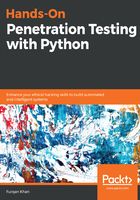
About Python – compiled or interpreted
Compilers work by converting human-readable code written in high-level programming languages into machine code, which is then run by the underlying architecture or machine. If you don't wish to run the code, the compiled version can be saved and executed later on. It should be noted that the compiler first checks for syntax errors and only creates the compiled version of the program if none are found. If you have used C, you might have come across .out files, which are examples of compiled files.
In the case of interpreters, however, each line of the program is taken and interpreted from the source code at runtime and then converted into machine code for execution. Python falls into the category of interpreted byte code. This means that the Python code is first translated to an intermediate byte code (a .pyc file). Then, this byte code is interpreted line by line by the interpreter and executed on the underlying architecture.